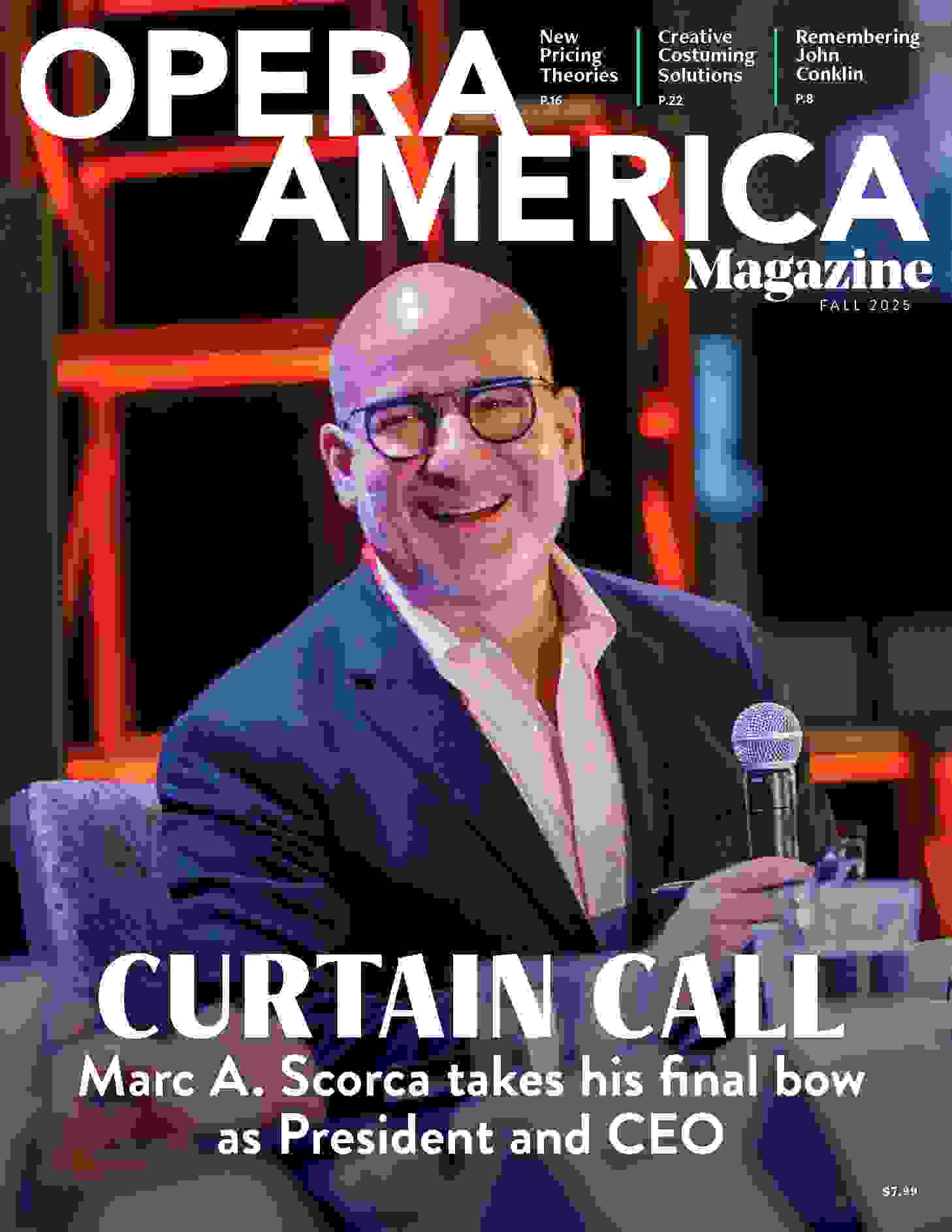Where Are Our Singers of Color? Part 2
African American and Latinx singers can face disproportionately large obstacles in their progress toward a career. An OPERA America project seeks to uncover contributing factors — and work toward solutions.
Key Figures Speak Out
Improving the Presence of Singers of Color in Opera
Finding the inhibiting factors preventing people of color from reaching opera’s stages is easy. Determining a cohesive and systematic means of addressing those factors is a more complex issue. The obstacles to righting this historical imbalance were a major focus of a March 26 OPERA America meeting that gathered singers of color and representatives from opera organizations to address the “constrictions” that African American and Latino singers encounter as they move along the “pipeline” to an opera career. (I myself participated to offer my insights and chronicle the proceedings.)
Almost from the start, a question arose as to whether the nomenclature OPERA America had chosen for the process might impose its own set of “constrictions.” New York Youth Symphony’s executive director, Shauna Quill, suggested replacing “pipeline,” implying one narrow course, to “pathway,” implying numerous routes. Her words resonated with many of the panelists: Since the obstruction or expulsion of artists of color from that single channel is a primary problem, creating multiple routes might allow more of them to survive the journey. Still, changing what you call a thing does not alter what it is. That can only happen once you take the actions to transform it.
An organization’s leadership, it emerged, often has a decisive effect on its embrace of diversity. Laura Lee Everett, OPERA America’s chief programs officer, cited Washington National Opera and The Glimmerglass Festival, both of them under the direction of Francesca Zambello. The two companies, during the 2014–2015 and 2015–2016 seasons, reported over 32 percent non-white singers in their casts, 10 percent higher than the average among companies surveyed. According to Amy Siegler, the National Chorale’s executive director, once Everett McCorvey, an African American, took over as the Chorale’s artistic director, he started to engage “people who look like him,” resulting in greater diversity in the chorus’ roster of singers.
Contemporary operas, some by non-white composers, reflect more diverse storytelling and require diverse casting. Diane Wondisford, president and producing director of Music-Theatre Group, cited her company’s production of a Yiddish opera that was workshopped in Cuba and performed with a diverse cast in a Cuban nightclub. Soprano Harolyn Blackwell, a member of the vocal performance faculty at New York University, spoke of an NYU project that used Ricky Ian Gordon songs to present students’ personal stories of immigration.
Still, the diversity displayed in new works may present a false sense of progress. The casting of canonical operas, the meeting’s participants agreed, remains a problem. When companies cast by ethnicity rather than talent, they are still gatekeeping and marginalizing artists of color. When companies create vehicles for singers of color, but fail to integrate those singers into standard repertory, they create a separate-but-not-equal situation. Artists are measured by the great classical roles.
The panelists noted hurdles in the early stages in the pipeline — that is, the cultural and educational conditions that children of color face. To attract them to the field, opera must move past its image of elitism and racial exclusion. One conclusion: Representation breeds inspiration. Soprano Adrienne Danrich recounted how her one-woman show opens the minds of children of color, both to the music and to new ideas about who might offer it.
I reached my own conclusions about the concept that “black people don’t do opera.” While this is usually attributed to classism, or to a lack of desire, appreciation or education, it is in fact rooted in systematic racism and the laws of segregation that prohibited blacks from participating in activities — from opera and ballet to golf and skiing — making them literally not for black people. The “black people don’t do opera” construct is a psychological byproduct of systemic marginalization and exclusion. The infantilizing idea that black people need to be “taught” to appreciate classical forms positions white people once again as the saviors of a people they victimized.
The singers of color in the room, sharing their lived experiences, offered the most useful insights of the day. Baritone Kenneth Overton articulated succinctly how the current structure of the pipeline narrows toward the middle; that is, after high school, when access to free training (through school programs and youth choral groups) transitions to that of university and conservatory training, which requires money. As the rigor and quality of study and experiences intensifies, the constrictions tighten further. Without private coaching, along with access to auditions, competitions and youth festivals — all of them requiring financial outlay — it is almost impossible to truly compete. All the efforts to pack the early pipeline with diversity is meaningless without a through line into conservatories and elite training.
Overton cited historically black colleges and universities (HBCUs) as containing untapped pools of talent that wizen due to lack of “expertise in training and information from the larger industry.” Due to HBCUs’ paucity of vigorous language courses and private coaching, their students suffer from weak technique, which creates insurmountable deficiencies as they move further along the pipeline. If a singer’s language skills aren’t good or they have not had proper coaching, they will not advance in competitions and they will be shut out of young artist programs, and therefore will have little chance of gaining representation and landing jobs. This domino effect places an economically disadvantaged artist (of any race) in a losing game of catch-up. The pipeline offers one narrow way of attaining a career in opera, and it lets artists of color drip out of the system.
Lawrence Edelson, artistic and general director of Opera Saratoga, admitted that he had never thought of auditioning at HBCUs for his company’s young artist program. This insight yielded a concrete action for OPERA America to take: the cultivation of relationships between YAPs and HBCUs, facilitating connectivity and the sharing of resources.
Porgy and Bess was called out as “the elephant in the room”: a work that provides job opportunities for black singers, but also tends to ghettoize them. Companies claim to have a hard time finding singers of color for traditional operas, yet no house has trouble casting Porgy. Haroyln Blackwell, a noted Clara in Porgy, said that she would refuse to sing the role unless the company also paired the offer with another assignment, asking her manager, “Do they know I sing Mozart?”
The topic of casting black singers solely in black operas opened a Pandora’s box of implicit bias and exploitative practices in the opera world toward artists of color. Overton spoke candidly of feeling marginalized when trotted out as a “show pony” for community outreach when in black productions. “I never get asked to do community outreach when I am singing Bohème,” he said.
Overton and Blackwell recounted makeup artists and lighting designers having neither the proper products nor skills to work with their skin tones, and they said that when they advocated for themselves, they were labeled “difficult.” Lighting designers may know how to light a set beautifully, but not a brown body. In this way, artists of color are made to feel like a nuisance or a burden. This is not what inclusion looks or feels like. The sentiment was that any steps toward inclusion for singers of color mean little if the industry isn’t ready to accommodate them. These factors amount to a further disincentive for singers of color. “[Black students] know it, they talk about it, it is on their minds and often they chose to not engage,” said Emma Griffin, managing artistic director of Mannes Opera.
Throughout the meeting, I felt that the voices of color present were the most effective in bringing the humanity of the issue into the room. If the field of opera wants to improve its pipeline, it should concentrate on the people, not the practice, and educate itself on what it feels like to traverse the pipeline in a brown body by engaging with the artists and the communities it seeks to enroll. It’s folly to address the pipeline when the endpoint is not a welcoming space. You can turn a pipeline into a pathway but the destination has be desirable.
What all people of color need is the equity of opportunity and entry. Repairing the pipeline is not about patching a hole; it’s about healing a historical wound.
This article was published in the Summer 2019 issue of Opera America Magazine.

Theresa Ruth Howard
Theresa Ruth Howard is a writer, dancer, and teacher. She is the founder and curator of MOBBallet, which preserves, presents, and promotes the contributions and stories of Black artists in ballet.






